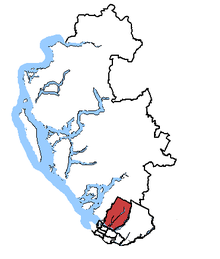North Vancouver (electoral district)
|
|
|||
|---|---|---|---|

North Vancouver in relation to other Greater Vancouver federal electoral districts.
|
|||
| Federal electoral district | |||
| Legislature | House of Commons | ||
| MP |
Liberal |
||
| District created | 1987 | ||
| First contested | 1988 | ||
| Last contested | 2015 | ||
| District webpage | profile, map | ||
| Demographics | |||
| Population (2011) | 109,639 | ||
| Electors (2015) | 82,085 | ||
| Area (km²) | 342 | ||
| Pop. density (per km²) | 320.6 | ||
| Census divisions | Greater Vancouver | ||
| Census subdivisions | North Vancouver (city), North Vancouver (DM), Greater Vancouver A | ||
North Vancouver is a federal electoral district in the province of British Columbia, Canada, that has been represented in the House of Commons of Canada since 1988.
Ethnic groups: 71.9% White, 6.9% West Asian, 4.8% Chinese, 4.3% Filipino, 2.8% South Asian, 2.4% Korean, 2.2% Aboriginal, 1.6% Japanese, 1.0% Latin American
Languages: 71.8% English, 6.7% Persian, 3.2% Chinese, 2.2% Korean, 2.0% Tagalog, 1.8% French, 1.8% German, 1.4% Spanish
Religions: 47.2% Christian (18.2% Catholic, 7.0% Anglican, 6.6% United Church, 1.6% Lutheran, 1.5% Presbyterian, 1.4% Christian Orthodox, 1.3% Baptist 9.6% Other), 6.3% Muslim, 42.5% No religion
Median income (2010): $35,034
Average income (2010): $49,652
This district includes the entirety of the City of North Vancouver and the majority of the District of North Vancouver.
This riding was created in 1987 from portions of North Vancouver—Burnaby and Capilano electoral districts.
The 2012 federal electoral boundaries redistribution concluded that the electoral boundaries of North Vancouver should be adjusted, and a modified electoral district of the same name will be contested in future elections. The redefined North Vancouver loses the eastern portion of its current territory to the new district of Burnaby North—Seymour, while its western boundary with West Vancouver—Sunshine Coast—Sea to Sky Country is adjusted to correspond to the boundaries between the District of North Vancouver, West Vancouver and the Capilano Indian Reserve. These new boundaries were legally defined in the 2013 representation order, which came into effect upon the call of the 42nd Canadian federal election, scheduled for October 2015.
...
Wikipedia
